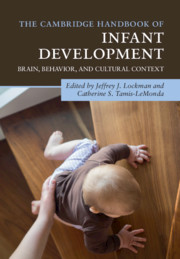Book contents
- The Cambridge Handbook of Infant Development
- The Cambridge Handbook of Infant Development
- Copyright page
- Dedication
- Contents
- Illustrations
- Contributors
- Preface
- Part I Foundations
- Part II Perceptual Development
- Part III Cognitive Development
- 12 Infant Memory
- 13 Infant Physical Knowledge
- 14 Infant Categorization
- 15 Early Knowledge About Space and Quantity
- 16 Infant Learning in the Digital Age
- Part IV Action
- Part V Language
- Part VI Emotional and Social Development
- Index
- References
15 - Early Knowledge About Space and Quantity
from Part III - Cognitive Development
Published online by Cambridge University Press: 26 September 2020
- The Cambridge Handbook of Infant Development
- The Cambridge Handbook of Infant Development
- Copyright page
- Dedication
- Contents
- Illustrations
- Contributors
- Preface
- Part I Foundations
- Part II Perceptual Development
- Part III Cognitive Development
- 12 Infant Memory
- 13 Infant Physical Knowledge
- 14 Infant Categorization
- 15 Early Knowledge About Space and Quantity
- 16 Infant Learning in the Digital Age
- Part IV Action
- Part V Language
- Part VI Emotional and Social Development
- Index
- References
Summary
Over the past decades, we have learned a great deal about what infants bring to the task of mastering space and quantity, and what they subsequently add to these starting points. The accumulating findings are richly descriptive, and they are beginning to illuminate long-standing questions concerning the origins of knowledge in these domains. Broadly speaking, there have been two contending theoretical approaches. The core knowledge view claims that infants are born with representationally specific processing modules tuned to picking up the geometry of space (the geometric module), forming representations of objects (continuity, cohesion, contact, tracking small sets), and assessing the number of objects (the approximate number system) (Feigenson, Dehaene, & Spelke, 2004; Spelke & Kinzler, 2007). In this way of thinking, subsequent developmental change comes mainly from augmentation of the power and scope of these innate modules, as children acquire language and other forms of symbolic processing.
Keywords
- Type
- Chapter
- Information
- The Cambridge Handbook of Infant DevelopmentBrain, Behavior, and Cultural Context, pp. 410 - 434Publisher: Cambridge University PressPrint publication year: 2020



